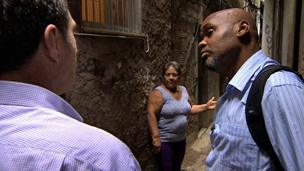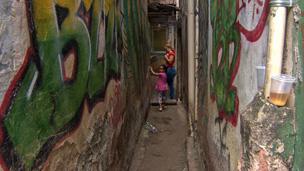Life inside Rio's slum city
- Published
- comments
David Shukman takes a walk through the streets of Brazil's largest favela, Rocinha
Along the highway linking the luxury hotels of Copacabana and the conference halls of the Rio+20 summit, the darkened windows of the VIP limousines will not have offered a clear view of the crowded hillside known as Rocinha.
Pronounced "Hosinia", this dense mass of tiny dwellings perched beneath a series of grey cliffs holds the dubious title of being Brazil's largest favela - a tightly-knit community of 120,000.
At the entrance to this slum city, as the police sirens and outriders cut a path through the swirling traffic for a president or prime minister, I wondered about the value of a summit document that makes eradicating poverty the top priority.
The second paragraph of the 49 pages recording the summit's conclusions refers to poverty as "the greatest global challenge facing the world today".
Yet as I was guided around Rocinha by its former leader, Carlos Costa, it became clear that - yet again - there's a gulf between the words bandied about at a conference and the daily grind confronting people outside it.

Carlos Costa, right, guiding the favela tour
Carlos wanted to give me a balanced view of life inside Rocinha to prove it's not all bad. Major improvements have been carried out recently and Carlos liked the idea that the summit might conceivably foster better conditions.
But, as he put it to me, the leaders "holed up" in their summit were on a different planet to the struggling citizens of the favela.
Six months ago, the police carried out a massive "pacification" - an aggressive operation to root out the drugs gangs that had made normal life impossible, and the authorities had followed up with a vigorous investment programme in:
new schools
a library (with a queue of eager children outside it)
sports facilities
All this has come in conjunction with the action against the heavily-armed crime lords.
But to see the most startling evidence of progress, Carlos had to lead me through a labyrinth of alleyways, twisting down haphazard steps, and through what felt like the darkened floor of a rainforest beneath a canopy of washing and wiring.
We passed turnings leading to smaller alleys, open doorways through which came the sizzle of frying garlic, women and children peering from windows high above us.

Dwellings crowd the hillside
This was not the poverty of sub-Saharan Africa. The children all had shoes - a key test - and satellite dishes sprouted from many rooftops and balconies. Also, this particular route through the slums was surprisingly clear of rubbish.
But as we squeezed through a narrow gap between buildings, and descended further into the gloom, it was hard to imagine the summit dignitaries ever making the same trip. Compose elegant phrases about poverty for the conference text, sure, but pick a path through the mud - no thanks.
The dark soon gave way to the open sky of Street Four - a bright, well-paved road sliced through the alleyways to create a more pleasant environment. This is one of Rocinha's key improvements, funded by the government. It makes a very big difference - but only to one part of the favela, Carlos told me.
Visits to the slums were laid on for conference delegates but, existing behind walls of high security, summits create their own intense bubbles of activity which can become detached from reality. So references to poverty are prominent in the conference text but without any clear sign of how they will translate into change on the ground.
.jpg)
The same goes for the starkly sharp choices I witnessed in the Amazon rainforest, nearly 2,000 miles to the north of Rio at Carajas.
How to balance the demands of economic growth with the impact on the natural world? The world's largest iron ore mine is smack in the middle of a national park, as I reported earlier this week.
The company operating the mine, Vale, has a terrible environmental reputation in Brazil but has recently adopted a green policy and started trumpeting its green credentials - like many giant corporations, it has a high-profile presence at the summit and promises to restore the rainforest at Carajas.

Protest against mining company Vale
The dilemma for the authorities is whether to allow the mine to expand into new areas - to turn untouched forest or savannah or unusual caves into gigantic chasms to create valuable exports and jobs - or call a halt for the sake of the natural world.
The 49 pages from the summit do not really provide an answer. On the one hand, economic growth must be supported. On the other, environmental impact must be considered. One might say, we already knew that.
For those interested in the exact quote, here's part of it:
"… we reaffirm the need to achieve economic stability and sustained economic growth, promotion of social equity, and protection of the environment…"
In other words, do both - develop and protect.
So what was the point of the whole event? A fair question. I find myself making comparisons with the tumultuous and chaotic climate change conference at Copenhagen in December 2009. For those of us who were there, icy Denmark bore striking parallels with sultry Rio.
The contradictory briefings, the official spin, the frustration of campaigners fighting to get in to the talks or trying to get attention by walking out of them - all this was evident at both events. It is possible that gatherings of this global scale, where the participants arrive with markedly different agendas, are simply too large for any diplomats, however skilled, to manage successfully.
The Brazilians achieved an outcome by closing off debate and forcing the pace. It meant the leaders did not have to waste their time arguing over small print.
But the result was a document that is not recommended reading: laden with jargon, and with phrases counterbalanced to please everyone and mean little.
In the end, one might expect the UN's largest ever gathering, billed as a crucial follow-on to the Earth Summit, to produce something more illuminating.
But reading it provides no tangible answers for the two key questions I have encountered in the past week: how best to assist urban dwellers living in miserable conditions and how to reconcile demand for resources when the natural world has to pay a price.

Residents do not want to be painted as victims of circumstance
Meanwhile, the people of Rocinha, ignoring the wail of the VIP sirens and unwilling to be portrayed as victims, have come up with a few of their own solutions.
There is a business collecting cans and bottles and selling them on - a kind of entrepreneurial recycling operation.
And Zenilton Marinho has done on a tiny scale what the mining company has promised to do in the Amazon with its pledge to restore the rainforest. He has started cultivating a miniature wood along the edge of the newly created Street Four. He has planted a line of saplings and protects them with lengths of salvaged cable and plastic bottles.
All week there's been debate about sustainable development and what it means. The most popular definition is that it's about this generation living in a way that does not wreck things for the next one. Zenilton has another definition. It involves having a vision for a better world and not waiting for anyone to tell you how to achieve it.